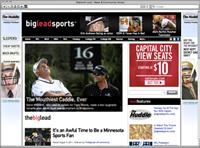In the early days the site was frequently compared, for better or worse, to Deadspin, but since then, the two’s paths have diverged. “Both sites have morphed from something that was a blog a few years ago into something grander,” McIntyre says, adding that he’s most proud of The Big Lead’s sports media coverage, before getting to the point where he feels the sites part sympathies: “Dong shots are certainly not our bread-and-butter.”
McIntyre, a former reporter at the Bergen Record and US Weekly, started the site with a couple of friends in February 2006, and by late 2007 he had quit his day job to run the site full-time. In a March 2008 Sports Illustrated article McIntyre unmasked himself as the lead blogger behind The Big Lead, where he had been writing under a pseudonym, and from there the site steadily crept toward the mainstream. By the end of 2008 the site had conducted twenty-eight interviews with sports reporters, including Jon Wertheim of Sports Illustrated; Buzz Bissinger, the author of “Friday Night Lights”; and Tony Kornheiser, then of the Washington Post. The format was quickly becoming their specialty. “At this point we realized the more we wrote about the media, the more the media would pay attention,” McIntyre told Sports Illustrated. “They liked reading about their colleagues and their peers.”
By 2009 the site was profitable enough that McIntyre had hired a handful of freelancers to contribute, and by June 2010 he sold the site, for a number somewhere in the low seven-figures, to a venture capital firm. McIntyre remains at the site as editor-in-chief.
The firm, known as Fantasy Sports Ventures, rebranded the blog as Big Lead Sports before adding it to a stable of several other sites that the company says attract 17 million unique visitors monthly. Other sites the company owns include sports-specific news sites like HoopsHype and fantasy sports-centered sites like The Huddle and BaseballHQ. Chris Russo, the CEO of Fantasy Sports Ventures, estimates monthly unique visitors across his entire suite of sites at 17 million. The Big Lead makes up a relatively small percentage of that with a broad range of between 1 and 2 million monthly uniques, according to Russo, though he stresses that the Big Lead Sports brand is pervasive throughout the suite of sites and that traffic to The Big Lead alone does not reflect the content’s total viewership.
Fantasy Sports Ventures says that the conglomeration of properties has made it easier for the company to market itself to advertisers–meaning that The Big Lead has a value to them beyond raw traffic. They employ ten people in their in-house direct sales operation, and a source with direct knowledge of the company’s financials, who asked not to be named when discussing revenue figures, says that the network as a whole was profitable in the second half of 2010, with revenues in the seven figures.
Russo says that the company–which is backed by private investors as well as more traditional media companies, like Gannett–is still in expansion mode. “We plan to acquire additional sites in the future as part of an overall growth strategy,” Russo says, adding that the company planned to continue to focus exclusively on sports sites for now. McIntyre, for his part, says that there was little doubt that he would sell to the company when he was approached by Fantasy Sports. “They made me an offer I couldn’t turn down,” he says. “I got lucky.”
The sale not only validated McIntyre’s entrepreneurial instincts, but also freed him from having to deal with the back-end of the business, selling ads and worrying about the day-to-day financial outlook. Now McIntyre focuses solely on overseeing all of The Big Lead’s editorial content and its staff of five writers. McIntyre says that he also plans to hire at least one more additional writer in September 2011 to add to the media beat. “We do stuff that a lot of others don’t,” McIntyre says, before adding that he couldn’t help keeping a close eye on his competitors. “But I still check in to Deadspin religiously.”
 NEW YORK, NEW YORK — The Big Lead first entered the consciousness of the sports media world around 2006, when then-Kansas City Star sports columnist Jason Whitlock trashed a series of colleagues in a flame-throwing interview that, for a few days at least, lit up the Internet. Less than a year after that the site received a bigger, if more unlikely, boost after the ESPN radio personality Colin Cowherd encouraged his listeners to crash the site by flooding it with visits, taking it out for around two days. Both incidents highlighted what co-founder Jason McIntyre says has become one of the site’s specialties: covering the media, and in turn being covered by the media. The site combines that formula with liberal coverage of professional athletes’ transgressions off-the-field as well as offbeat coverage of more quotidian sports stories, like NFL Draft news or pointed takes on Tiger Woods.
NEW YORK, NEW YORK — The Big Lead first entered the consciousness of the sports media world around 2006, when then-Kansas City Star sports columnist Jason Whitlock trashed a series of colleagues in a flame-throwing interview that, for a few days at least, lit up the Internet. Less than a year after that the site received a bigger, if more unlikely, boost after the ESPN radio personality Colin Cowherd encouraged his listeners to crash the site by flooding it with visits, taking it out for around two days. Both incidents highlighted what co-founder Jason McIntyre says has become one of the site’s specialties: covering the media, and in turn being covered by the media. The site combines that formula with liberal coverage of professional athletes’ transgressions off-the-field as well as offbeat coverage of more quotidian sports stories, like NFL Draft news or pointed takes on Tiger Woods.
